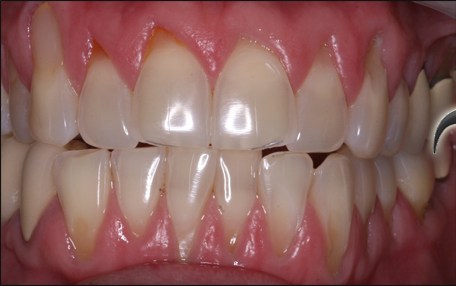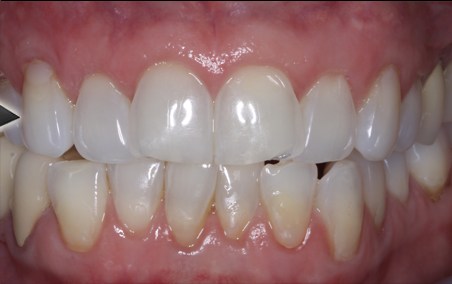Gum Recession Treatment In Glendale
Our Minimally Invasive Gum Grafting ensures your gums will look like new!
You’ve heard the expression “long in the tooth,” meaning getting on in age, and it’s true that nothing ages a face more than gums that have receded. In modern times people don’t have to live with their receding gums and can undergo gum graft surgery to cover the exposed tooth roots.
What causes receding gums?
Gum recession is the exposure of the tooth roots caused by the gum tissue retracting. Gum recession is most commonly caused by:
- Genetics
- Teeth that are out of alignment
- Teeth grinding
- Trauma to the teeth
- Overly aggressive brushing or flossing
- Severe gum disease


Before & After Gum Recession Treatment
The dangers of gum recession
Root surfaces are softer than tooth enamel and so are more prone to erosion and are more sensitive to heat, cold and even sweets. They can get so worn that the teeth loosen or break.
Gum Recession Consultation
Start on your road to rejuvenated gums with a consultation with Dr. Hendry. We will evaluate the extent of the gum recession, creating a map of where the gum line has receded.
We also check for other issues that might need to be handled to prevent gum recession from continuing. You will get treatment plan options and advice on the best path to choose for your specific condition.
To make an appointment, call (818) 240-4555 or click here to request an appointment online.
Treatment for thin gums
Gum grafting can also be used to treat gums that are too thin. Thin gums can’t support a tooth properly and will eventually lead to gum recession and bone loss.
Microsurgical treatment
Traditional gum graft surgery is a lengthy and painful procedure. However, with new advancements, Dr. Hendry can repair your gums with a fast and comfortable minimally invasive procedure known as microsurgery.

Our doctors use illuminated microsurgical instruments to perform precision surgical procedures.
Microsurgery uses small instruments with illuminated microscopes. This means small incisions with far less suturing needed and far less discomfort post-treatment. Instead of cutting into the gum, our doctors create a small tunnel in the neck of the tooth in which to insert the gum graft.
Pinhole Surgical TechniqueTM
The most recent development in gum grafting for receding gums is the Pinhole Surgical Technique. Dr. Hendry is trained in this new technique. With the pinhole technique, receding gums are treated by shifting the gum tissue over the exposed roots through minute pinholes, and stabilizing the gums in position with collagen. No sutures are required. The entire mouth can be treated in just one visit!
Minimally invasive
Microsurgical techniques make our gum grafting minimally invasive. We only need to use local anesthesia, although sedation is an option for long appointments and for patients who are anxious. No prescription medicines are needed after treatment, just over-the-counter pain killers for a couple of days, if the patient so chooses.
Minimally invasive also means minimal impact on the body. Conventional gum grafting requires the sacrifice of healthy gum tissue and can lead to further gum loss after healing. There is an additional cosmetic benefit: conventional surgery leaves a white patch that doesn’t blend aesthetically. With our minimally invasive techniques, your new gum is naturally pink.

Gum Disease Treatment
Dental Implants
How Gum Grafting works
 Treatment varies according to which type of gum grafting is decided upon, but all treatment follows the below basic steps.
Treatment varies according to which type of gum grafting is decided upon, but all treatment follows the below basic steps.
With microsurgical gum grafting we can obtain the gum tissue we need the same day as the gum graft. (Traditional gum graft surgery requires a separate visit for tissue collection and a one- to two-week healing period.) In some cases we will use donated gum tissue or synthetic tissue, such as collagen in the Pinhole Surgical Technique.
We use a special surgical microscope to view the inside of your mouth at up to 24 times magnification. This allows our doctors to use small instrumentation and thus they need only make tiny incisions. It also increases the field of vision, providing more accurate and successful surgery.
Generally, we recommend treating the full mouth in two visits of two hours. If only a few teeth are affected, the patient should be in and out in about forty minutes. In certain situations we use plasma-rich growth factors (PRGF) from the patient’s own blood to boost healing.
Post treatment, most people take a couple of doses of over-the-counter pain medication for a day or two. We like to see our patients for three follow-up visits over a period of three to six months.
Our Gum Graft options
We use four main ways to obtain gum graft material. We decide which to use based on the condition of the patient’s gums and teeth as well as the patient’s own preferences.

-
Traditional Gum Grafting
uses the patient’s own connective tissue from the roof of the mouth. Using the traditional method of gum graft surgery, an incision is made to collect the tissue. The incision has to be covered up with surgical dressing and takes up to two weeks to heal. The procedure can be painful and requires prescription medication. Our doctors will use this procedure on rare occasions when more fibrous tissue is needed.

Traditional gum grafting procedures usually take several weeks to heal. Our minimally invasive, non-surgical methods allows for almost immediate healing.
- Using micro surgical techniques, we can harvest the needed tissue from the roof of the mouth using the “trapdoor” method. This is done by making a small incision in the roof of the mouth, which is then sewn up. The incision heals in one to two days and only over-the-counter pain medication is needed, if at all.
- In some cases our doctors opt to use donated sterilized human tissue. This is especially useful for patients sensitive to any type of surgery.
- Collagen use in the Pinhole technique. Collagen is the main structural protein found in fibrous tissue such as skin, ligaments and bone. It provides elasticity and strength. The Pinhole Technique does not require a tissue graft other than the use of collagen. The patient’s existing gum tissue is repositioned (not cut) to cover the exposed tooth roots and collagen is used to stabilize the gums in their new position.
Gum Recession Treatment
Receding gums can spell trouble for your oral health, and they can also be the source of a lot of discomfort and embarrassment. Fortunately, modern dental techniques are able to reverse receding gums in order to preserve your teeth, reduce sensitivity, and restore your healthy smile.
Read on to learn more about the causes and the dangers of receding gums, as well as the gum recession treatments that Glendale Periodontics can provide.
What Causes Gum Recession?
Some of the causes for gum recession are avoidable — typically through maintaining a great oral hygiene routine — but there are others that no amount of regular brushing and flossing can prevent. Some of the most common reasons why you may be suffering from receding gums include:
- Periodontal disease
- Genetics
- Poor oral hygiene
- Hormones
- Brushing your teeth too hard
- Tooth grinding and clenching
- Tobacco use
- Crooked or misaligned teeth
- Lip or tongue piercings
- Dental trauma
As you can see, the causes are many, and not all are under your control.
Do I Need Receding Gumline Treatment?
Depending on the amount of recession, you may not be experiencing many issues with your receding gums, but that doesn’t mean you’re not going to have problems down the road if you don’t have them treated now.
This reality is particularly true if the cause of your receding gums is periodontal disease, as this infection of the gums can result in a number of different oral health problems, including loose teeth and tooth loss. Periodontal disease has even been connected to a number of other overall health issues, including heart disease and diabetes.
Even if the recession is not being caused by periodontal disease, you’re likely to start feeling some pain and discomfort from your receding gums once the gumline has pulled away from the tooth enough.
The part of the tooth beneath the gums is a lot more sensitive than the exposed part, so you’re likely to start feeling a significant increase in tooth sensitivity. You’re also at risk of the gum receding enough for the tooth to become loose or even fall out.
How Can I Reverse Receding Gums?
There are a few different procedures available that can help reverse receding gums, and with the help of cutting-edge dental technology, they’re now a lot less painful and a lot more effective. Glendale Periodontics provides the following gum recession treatments that can save your teeth and improve your quality of life:
Microsurgical Treatment
A fast and minimally invasive microsurgery procedure that uses small instruments with illuminated microscopes.
Pinhole Surgical TechniqueTM
A brand-new gum recession treatment technique that requires no sutures at all and can be performed in one single visit.
How Much Does Gum Recession Treatment Cost?
There are a few different factors that will determine the cost of your gum recession treatment. Typically, dental insurance will cover at least part of the procedure, provided it’s being performed for medical purposes, not cosmetic ones. In certain cases, medical insurance may even be able to cover some of the costs.
The extent of the gum recession is an important factor to consider when determining the price of the gum recession procedure. The more extensive the recession, the more expensive it’s going to be. The typical price range of any procedure to reverse receding gums is somewhere between $600 and $1200 or more per tooth without insurance.

